
Kennedia is a genus of thirteen species of flowering plants in the in the pea family Fabaceae and is endemic to Australia. Plants in this genus are prostrate or climbing perennials with trifoliate leaves and large, showy, pea-like flowers. There are species in all Australian states.
Banksia tortifolia is a small, spreading, prostrate shrub that is endemic to the southwest of Western Australia. It has short underground stems, pinnatipartite leaves with sharply-pointed, linear lobes on each side, greenish-cream, yellow and pink flowers in heads of about eighty, and glabrous, egg-shaped follicles.

Kennedia nigricans, commonly known as black kennedia, is a species of flowering plant in the family Fabaceae and is endemic to the south-west of Western Australia. It is a trailing or twining shrub or climber with trifoliate leaves and black and yellow-orange flowers.

Kennedia coccinea, commonly known as coral vine, is a species of flowering plant in the family Fabaceae and is endemic to the south-west of Western Australia. It is a twining, climbing or prostrate shrub with trifoliate leaves and orange-pink, red and pink, pea-like flowers.

Kennedia prostrata, commonly known as running postman, scarlet coral pea or scarlet runner is a species of flowering plant in the family Fabaceae and is endemic to Australia. It is a prostrate or twining shrub with trifoliate leaves and usually red flowers.

Kennedia rubicunda, commonly known as the dusky coral pea, is a species of flowering plant in the family Fabaceae and is endemic to eastern continental Australia. It is a twining or prostrate herb with trifoliate leaves and dark red or purple flowers.
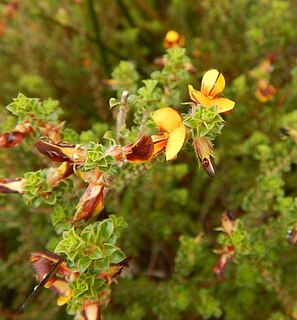
Pultenaea densifolia, commonly known as dense-leaved bush-pea, is a species of flowering plant in the family Fabaceae and is endemic to southern continental Australia. It is a spreading or low-lying shrub with broadly egg-shaped, down-curved leaves and clusters of purple or yellow, red and purple flowers.
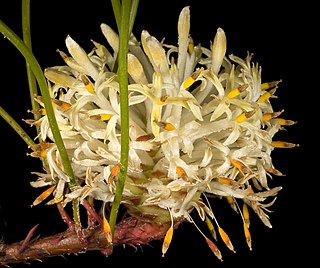
Petrophile prostrata is a species of flowering plant in the family Proteaceae and is endemic to southwestern Western Australia. It is a prostrate shrub with needle-shaped but usually not sharply-pointed leaves and spherical heads of hairy, pale yellow or cream-coloured flowers.

Kennedia retrorsa is a species of flowering plant in the family Fabaceae and is endemic to New South Wales. It is a climbing herb with trifoliate leaves and pinkish-purple or scarlet flowers.

Kennedia procurrens, commonly known as the purple running pea, is a species of flowering plant in the family Fabaceae and is endemic to eastern Australia. It is a prostrate or climbing herb with trifoliate leaves and pale red to mauve or violet flowers.

Kennedia lateritia, commonly known as Augusta kennedia, is a species of flowering plant in the family Fabaceae and is endemic to the south-west of Western Australia. It is a woody climber with twining stems, trifoliate leaves and orange-red and yellow flowers arranged in groups of up to twenty-four.

Hibbertia acicularis, commonly known as prickly guinea-flower, is a species of flowering plant in the family Dilleniaceae and is endemic to eastern Australia. It is an erect or prostrate shrub with linear to lance-shaped leaves and yellow flowers arranged singly in leaf axils with the six to eight stamens joined at the base, in a single cluster.

Bossiaea dentata is a species of flowering plant in the family Fabaceae and is endemic to the south of Western Australia. It is an erect, sometimes prostrate shrub with variably-shaped leaves and greenish-yellow or pink to burgundy-coloured flowers.
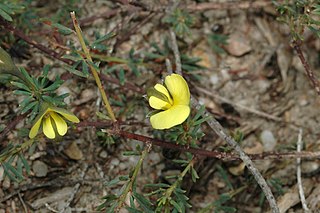
Gompholobium inconspicuum, commonly known as creeping wedge-pea is a species of flowering plant in the family Fabaceae and is endemic to south-eastern continental Australia. It is a prostrate or low-lying shrub with trifoliate leaves and pale lemon yellow to yellowish green, pea-like flowers.

Pultenaea subalpina, commonly known as rosy bush-pea, is a species of flowering plant in the family Fabaceae and is endemic to a restricted area of Victoria. It is a rigid, prostrate to erect or spreading shrub with linear leaves and pink, pea-like flowers.

Kennedia beckxiana, commonly known as Cape Arid kennedia, is a species of flowering plant in the family Fabaceae and is endemic to the south-west of Western Australia. It is a prostrate or twining shrub or a climber with trifoliate leaves and red and yellow, pea-like flowers.
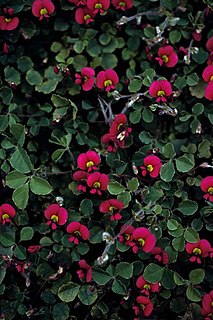
Kennedia carinata is a species of flowering plant in the family Fabaceae and is endemic to the south-west of Western Australia. It is a prostrate shrub with trifoliate leaves and reddish-purple, pea-like flowers.

Kennedia glabrata, commonly known as Northcliffe kennedia, is a species of flowering plant in the family Fabaceae and is endemic to the south-west of Western Australia. It is a prostrate shrub or creeper with trifoliate leaves and orange-pink to red flowers with a yellow centre.
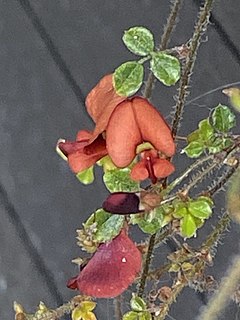
Kennedia microphylla is a species of flowering plant in the family Fabaceae and is endemic to the south-west of Western Australia. It is a prostrate, mat-forming creeper with relatively small, trifoliate leaves and red flowers.
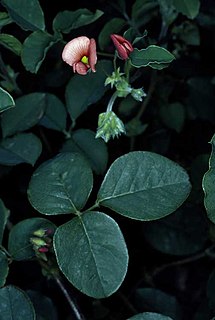
Kennedia stirlingii, commonly known as bushy kennedia, is a species of flowering plant in the family Fabaceae and is endemic to the south-west of Western Australia. It is a trailing or twining shrub with trifoliate leaves and orange-red flowers.



















